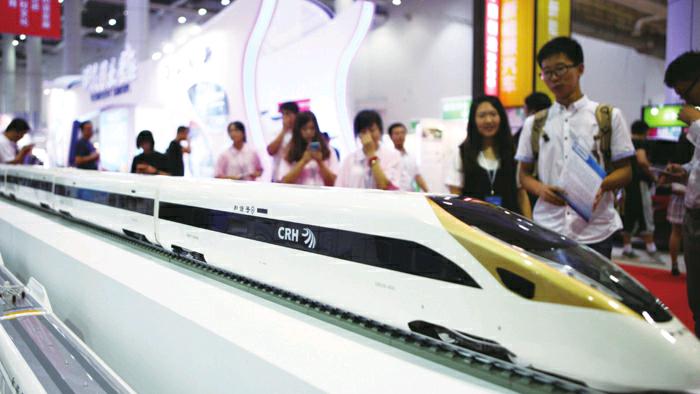Right of Value
2017-06-22ByLiXiaoyu
By+Li+Xiaoyu
The battles among tech giants are legend- ary. But whereas in the past Apple and Samsung used to trade blows over patents, theres a new major player in the ring. In a shift of roles, Chinas Huawei Technologies has joined in.
Huawei fi led a lawsuit against Samsungs subsidiaries in China, claiming that more than 20 models of Samsung smartphones and tablets, including the fl agship Galaxy S7 and Galaxy S7 Edge, have infringed its patents.
In April, the Quanzhou Intermediate Peoples Court in southeast Chinas Fujian Province ruled that Samsung Electronics should pay 80 million yuan ($11.6 million) to Huawei for patent infringements.
The court ruling marked the giant Chinese smartphone makers fi rst victory in safeguard- ing its intellectual property rights (IPRs) in the local market.
Huawei is one of the top Chinese brands with a large number of patents. According to statistics, by the end of 2016, the company had owned more than 55,000 patents worldwide, 90 percent of which are invention patents.
Huaweis victory over Samsung highlights the importance of innovation and patents. Its just one of the many successful cases of Chinese companies protecting their IPRs. Insiders believe that IPRs now play an important role in protecting creativity and driving innovation.
Focus on innovation
In the past, many Chinese companies had little awareness of IPR protection and suf- fered great losses for infringing upon IPRs of foreign enterprises. But they are looking to innovate for a consumer base that is increasingly demanding, said Shaun Rein in his book The End of Copycat China: The Rise of Creativity, Innovation and Individualism in Asia.
“Chinese companies are no longer copycats, but are instead innovating and adding value,” said Rein, who is the founder and managing director of the China Market Research Group, a strategic market intelligence fi rm headquartered in Shanghai.
This rise in innovation saw China recording extraordinary growth in international patent applications in 2016, up 44.7 percent year on year, according to a report released by the World Intellectual Property Organization (WIPO) on March 15.
A total of 43,168 applications were fi led in China through the Patent Cooperation Treaty (PCT) in 2016, putting the country in third place after the United States and Japan, the WIPO said. Since 2002, China has registered double-digit growth each year and will become the largest user of the PCT system within two years if this trend remains.
Chinas telecoms giants ZTE Corp., fi ling 4,123 PCT applications, and Huawei, with 3,692, occupied the top two spots in the list of PCT applicants, according to the report.
“The number of PCT applications is an important indicator that reflects industrial innovation capability and also a major index to evaluate international competitiveness of enterprises,” said Li Shunde, Dean of the Department of Law and Intellectual Property at the University of the Chinese Academy of Sciences.
“The numbers speak of the importance China attaches to IPR protection and the innovation capabilities of Chinese companies,”Li added.
Lis view was echoed by Chen Hongbing, Director of the WIPO Office in China. He said the country has joined the ranks of the worlds 25 most innovative economies, according to the Global Innovation Index 2016 report, jointly released by Cornell University in the United States, the European Institute of Business Administration and the WIPO.
Statistics from the Ministry of Science and Technology show that Chinas investment in research and development reached nearly 2.1 percent of the national GDP in 2016, totaling 1.544 trillion yuan ($224 bil- lion). The fi gure puts the country in second place in this category worldwide, next only to the United States.
“On an international level, the Chinabased fi lers are behind much of the growth in international patent and trademark fi lings,”said WIPO Director General Francis Gurry. He believes this will have a big impact on businesses internationalizing as the country continues its journey from made-in-China to created-in-China.
Protection essential
For Chinese enterprises, innovation and IPR protection are driven not only by the competitive global market, but also by their own development.
For more than 10 years since 2001, Chinese companies were the most investigated by the U.S. International Trade Commission (ITC), according to Chinas State Intellectual Property Offi ce (SIPO). In accordance with Section 337 of the Tariff Act of 1930, the ITC may investigate companies suspected of infringing IPRs of American companies.
However, this phenomenon has been changing. In recent years, an increasing number of Chinese companies are becoming more aware of IPR protection and have taken the initiative to integrate IP into their development strategies and plans.
“In the age of globalization, the internationalized operation of Chinese enterprises is inevitable. Its recommended that they should learn about IP-related legal risks and create strategies accordingly to reduce risks before entering foreign markets,” Chen said.

Nuctech, a leading supplier of security solutions and inspection products for airports, is one of the many Chinese companies taking the initiative in IPR protection.
The company has focused on IPR protection and management since its establishment to maintain a competitive edge amid fierce global industrial competition, said Guo Weihong, Deputy Director of the IP Department of Nuctech.
“IPR protection is no longer an optional choice, but rather a life-or-death matter,” she said. Her company files patent applications as soon as technological innovations are released.
Nuctech considers the IPR issue a top priority and has implemented a comprehensive IP strategy for years. “The IP strategy has helped us avoid the risk of patent infringement in new markets, build [our] brand and increase innovation capabilities and competitiveness,” Guo said.
The company had fi led more than 3,000 patent applications in over 20 countries by the end of 2016.
Institutional protection
Since joining the WIPO in 1980, China has made remarkable progress and achievements in the fi eld of IP development, thanks to the Chinese Governments efforts in strengthening the IPR protection legal system and its encouragement to improve innovation and competitiveness, Chen said. Chinas Patent Law, enacted in 1985, was amended in 1992, 2000 and 2008, and will undergo a fourth revision later this year.
Meanwhile, China has placed greater emphasis on strict law enforcement to create a good environment for IPR protection. According to the white paper 2016 Intellectual Property Rights Protection in China released by the SIPO in April 2017, administrative law enforcement departments investigated 189,000 cases related to IPR violations, while Chinas courts handled 172,000 IPR-related cases.
Special IPR courts were established in 2014 in Beijing, Shanghai and Guangzhou, which have brought about significant improvements and facilitated the fi ght against IPR infringement, according to experts.
“IPR protection plays an important role in driving technological innovation, economic growth and cultural development in China. We have great confi dence in the IP development in China,” Chen said.
